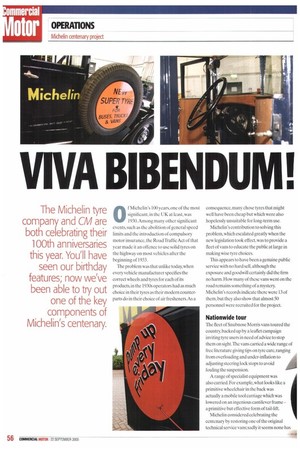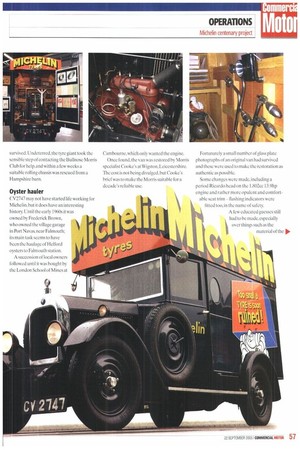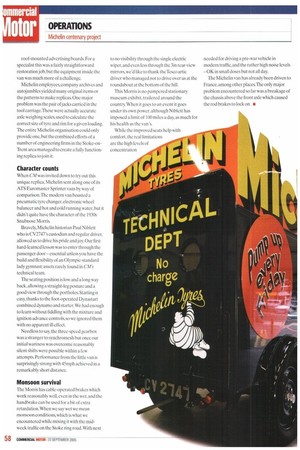VIVA BIBENDUNI!
Page 64

Page 65

Page 66

If you've noticed an error in this article please click here to report it so we can fix it.
The Michelin tyre company and CM are both celebrating their 100th anniversaries this year. You'll have seen our birthday features; now we've been able to try out one of the key components of Michelin's centenary.
Of Michelin's 100 years, one of the most significant, in the UK at least, was 1930. Among many other significant events, such as the abolition of general speed limits and the introduction of compulsory motor insurance, the RoadTraffic Act of that year made it an offence to use solid tyres on the highway on most vehicles after the beginning of 1933.
The problem was that unlike today, when every vehicle manufacturer specifies the correct wheels and tyres for each of its products. in the 1930s operators had as much choice in their tyres as their modern counterparts do in their choice of air fresheners. As a consequence, many chose tyres that might well have been cheap but which were also hopelessly unsuitable for long-term use.
Michelin's contribution to solving this problem, which escalated greatly when the new legislation took effect, was to provide a fleet of vans to educate the public at large in making wise tyre choices This appears to have been a genuine public service with no hard sell, although the exposure and goodwill certainly did the firm no harm. How many of these vans went on the road remains something of a mystery. Michelin's records indicate there were 13 of them, but they also show that almost 50 personnel were recruited for the project.
Nationwide tour
The fleet of Snubnose Morris vans toured the country backed up by a leaflet campaign inviting tyre users in need of advice to stop them on sight.The vans carried a wide range of free literature giving tips on tyre care, ranging from overloading and under-inflation to adjusting steering lock stops to avoid fouling the suspension.
A range of specialist equipment was also carried. For example, what looks like a primitive wheelchair in the back was actually a mobile tool carriage which was lowered on an ingenious cantilever frame — a primitive but effective form of tail-lift.
Michelin considered celebrating the centenary by restoring one of the original technical service vans; sadly it seems none has survived. Undeterred, the tyre giant took the sensible step of contacting the Bullnose Morris Club for help, and within a few weeks a suitable rolling chassis was rescued from a Hampshire barn.
Oyster hauler
CV2747 may not have started life working for Michelin, but it does have an interesting history Until the early 1960s it was owned by Frederick Brown, who owned the village garage in Port Navas, near Falmouth; its main task seems to have been the haulage of Helford oysters to Falmouth station.
A succession of local owners followed until it was bought by the London School of Mines at Cambourne, which only wanted the engine.
Once found, the van was restored by Morris specialist Cooke's at Wigston, Leicestershire. The cost is not being divulged, but Cooke's brief was to make the Morris suitable for a decade's reliable use. Fortunately a small number of glass plate photographs of an original van had survived and these were used to make the restoration as authentic as possible.
Some changes were made, including a period Ricardo head on the 1,802cc 13.9hp engine and rather more opulent and comfort able seat trim — flashing indicators were fitted too, in the name of safety.
A few educated guesses still had to be made, especially over things such as the material of the 1111. roof-mounted advertising boards. For a specialist this was a fairly straightforward restoration job, but the equipment inside the van was much more of a challenge.
Michelin employees, company archives and autojumbles yielded many original items or the patterns to make replicas. One major problem was the pair of jacks carried in the tool carriage.These were actually accurate axle weighing scales, used to calculate the correct size of tyre and rim for a given loading. The entire Michelin organisation could only provide one, hut the combined efforts of a number of engineering firms in the Stoke-onTrent area managed to create a fully functioning replica to join it.
Character counts When CM was invited down to try out this unique replica. Michelin sent along one of its ATS Euromaster Sprinter vans by way of comparison.The modern van boasted a pneumatic tyre changer, electronic wheel balancer and hot and cold running water, but it didn't quite have the character of the 1930s Snubnose Morris.
Bravely, Michelin historian Paul Niblett who is CV2747's custodian and regular driver, allowed us to drive his pride and joy.Our first hard-learned lesson was to enter through the passenger door— essential unless you have the build and flexibility of an Olympic-standard lady gymnast; assets rarely found in CMS technical team.
The seating position is low and a long way hack, allowing a straight-leg posture and a good view through the portholes. Starting is easy, thanks to the foot-operated Dynastart combined dynamo and starter. We had enough to learn without fiddling with the mixture and ignition advance controls, so we ignored them with no apparent ill effect.
Needless to say, the three-speed gearbox was a stranger to synchromesh but once our initial wariness was overcome reasonably silent shifts were possible within a few attempts. Performance from the little van is surprisingly strong with 45mph achieved in a remarkably short distance.
Monsoon survival
The Morris has cable-operated brakes which work reasonably well, even in the wet, and the handbrake can be used fora bit of extra retardation. When we say wet we mean monsoon conditions, which is what we encountered while mixing it with the midweek traffic on the Stoke ring road. With next to no visibility through the single electric wiper, and even less through the 3in rear-view mirrors, we'd like to thank the Tesco artic driver who managed not to drive over us at the roundabout at the bottom of the hill.
This Morris is no pampered stationary museum exhibit, trailered around the country. When it goes to an event it goes under its own power, although Niblett has imposed a limit of l00 miles a day, as much for his health as the van's.
While the improved seats help with comfort, the real limitations are the high levels of concentration needed for driving a pre-war vehicle in modern traffic, and the rather high noise levels — OK in small doses but not all day.
The Michelin van has already been driven to France, among other places:The only major problem encountered so far was a breakage of the chassis above the front axle which caused the rod brakes to lock on. •










































































































































































































